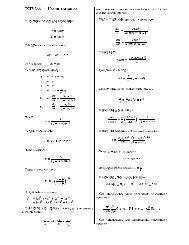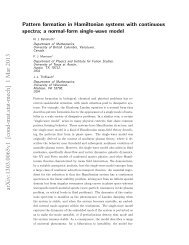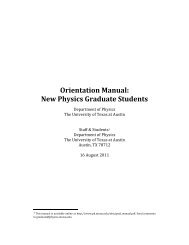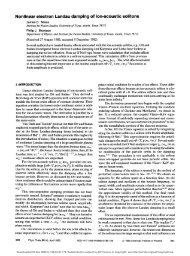Magnetic Fields and Magnetic Diagnostics for Tokamak Plasmas
Magnetic Fields and Magnetic Diagnostics for Tokamak Plasmas
Magnetic Fields and Magnetic Diagnostics for Tokamak Plasmas
You also want an ePaper? Increase the reach of your titles
YUMPU automatically turns print PDFs into web optimized ePapers that Google loves.
<strong>Magnetic</strong> fields <strong>and</strong> tokamak plasmas<br />
Alan Wootton<br />
17.33<br />
This expression can be further simplified <strong>for</strong> ρ > 1 by noting m 2 >> 1 (so all terms involving m 2<br />
disappear) <strong>and</strong> m 1 > 1 (so the term involving q a<br />
(m1+1) disappears) to give<br />
b rms<br />
b rmn<br />
=<br />
1<br />
( ) q a<br />
ln ρ<br />
m1 +1<br />
2ρ<br />
( )<br />
17.34<br />
This is the required result, giving us b rmn at the plasma edge in terms of the measured b rms<br />
outside the plasma. Because the terms involving m 2 have been ignored in deriving Equation<br />
17.34 it predicts (b rms /|b rmn |) ρ⇒1<br />
⇒ ∞. The more complete expression, remains finite, <strong>and</strong><br />
⎛<br />
⎜<br />
⎝<br />
b rms<br />
b rmn<br />
⎞<br />
⎟<br />
⎠<br />
r= a<br />
≈<br />
( m 2<br />
− m 1 )<br />
17.35<br />
2q a<br />
We conclude that the measured rms field outside the plasma (ρ > 1) is determined only by the<br />
lowest m number (m 1 ); the higher m numbers fall off too rapidly to contribute. Indeed, if<br />
Equation 17.34 is taken to represent the results, then a fit of the <strong>for</strong>m b rms ∝ r -γ gives the result<br />
γ = m 1<br />
+ 1+<br />
1<br />
2 ln ρ ( )<br />
17.36<br />
We can also measure the frequency of the fluctuations. We assume that the observed frequency<br />
is described by an expression of the <strong>for</strong>m<br />
f = ω 2π = m ⎛<br />
κ T e<br />
∂n e<br />
2πr mn<br />
B φ<br />
e n e<br />
∂r − E ⎞<br />
⎜<br />
r⎟ 17.37<br />
⎝<br />
⎠<br />
This is consistent with experimental results, with κ a factor of order 1. We also know<br />
experimentally that the term involving E r dominates the term involving κ, <strong>and</strong> that we can<br />
approximate the expression by<br />
f ≈ −cmE r<br />
2πr mn<br />
B φ<br />
17.38<br />
with χ a factor ≈ 1.5. E r is approximately constant <strong>for</strong> ρ < 1. We now relate r mn to q = m/n by<br />
assuming a specific q profile. For the simple q profile used in deriving the analytic results the<br />
trans<strong>for</strong>mation from r mn to m <strong>and</strong> n is given by Equation 17.31. A more realistic q profile gives<br />
130
















